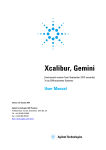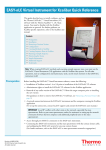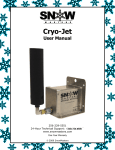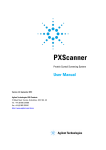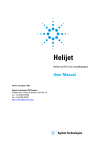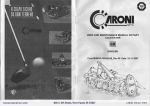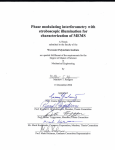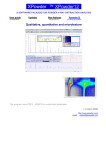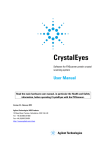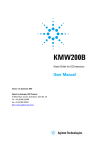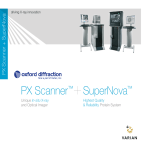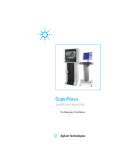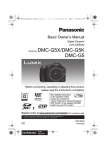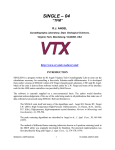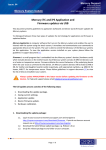Download User Manual - Agilent Technologies
Transcript
Xcalibur Gemini (including Ultra) Single Crystal Diffractometers User Manual Version 2.4, September 2011 e Agilent Technologies XRD Products 10 Mead Road, Yarnton, Oxfordshire. OX5 1QU, UK Tel: +44(0)1865 291600 Fax: +44 (0)1865 291601 http://www.agilent.com/chem Notices © Agilent Technologies, Inc. 2011 No part of this manual may be reproduced in any form or by any means (including electronic storage and retrieval or translation into a foreign language) without prior agreement and written consent from Agilent Technologies, Inc. as governed by United States and international copyright laws. For Assistance and Support http://www.agilent.com/find/assist Limitation of Warranty The foregoing warranty shall not apply to defects resulting from improper or inadequate maintenance by Buyer, Buyersupplied software or interfacing, unauthorized modification or misuse, operation outside of the environmental specifications for the product, or improper site preparation or maintenance. No other warranty is expressed or implied. Agilent Technologies specifically disclaims the implied warranties of Merchantability and Fitness for a Particular Purpose. Warranty The material contained in this document is provided “as is,” and is subject to being changed, without notice, in future editions. Further, to the maximum extent permitted by applicable law, Agilent disclaims all warranties, either express or implied, with regard to this manual and any information contained herein, including but not limited to the implied warranties of merchantability and fitness for a particular purpose. Agilent shall not be liable for errors or for incidental or consequential damages in connection with the furnishing, use, or performance of this document or of any information contained herein. Should Agilent and the user have a separate written agreement with warranty terms covering the material in this document that conflict with these terms, the warranty terms in the separate agreement shall control. Technology Licenses The hardware and/or software described in this document are furnished under a license and may be used or copied only in accordance with the terms of such license. Restricted Rights Legend If software is for use in the performance of a U.S. Government prime contract or subcontract, Software is delivered and licensed as “Commercial computer software” as defined in DFAR 252.2277014 (June 1995), or as a “commercial item” as defined in FAR 2.101(a) or as “Restricted computer software” as defined in FAR 52.227-19 (June 1987) or any equivalent agency regulation or contract clause. Use, duplication or disclosure of Software is subject to Agilent Technologies‟ standard commercial license terms, and non-DOD Departments and Agencies of the U.S. Government will receive no greater than Restricted Rights as defined in FAR 52.227-19(c)(1-2) (June 1987). U.S. Government users will receive no greater than Limited Rights as defined in FAR 52.227-14 (June 1987) or DFAR 252.2277015 (b)(2) (November 1995), as applicable in any technical data. Safety Notices CAUTION A CAUTION notice denotes a hazard. It calls attention to an operating procedure, practice, or the like that, if not correctly performed or adhered to, could result in damage to the product or loss of important data. Do not proceed beyond a CAUTION notice until the indicated conditions are fully understood and met. WARNING A WARNING notice denotes a hazard. It calls attention to an operating procedure, practice, or the like that, if not correctly performed or adhered to, could result in personal injury or death. Do not proceed beyond a WARNING notice until the indicated conditions are fully understood and met. Safety Summary General Safety Precautions The following general safety precautions must be observed during all phases of operation of this instrument. Failure to comply with these precautions or with specific warnings elsewhere in this manual violates safety standards of design, manufacture, and intended use of the instrument. Agilent Technologies Inc. assumes no liability for the customer's failure to comply with these requirements. Before operation, review the instrument and manual for safety markings and instructions. You must follow these to ensure safe operation and to maintain the instrument in safe condition. General Ground the Instrument This product is a Safety Class 1 instrument (provided with a protective earth terminal). The protective features of this product may be impaired if it is used in a manner not specified in the operation instructions. To minimize shock hazard, the instrument chassis and cover must be connected to an electrical protective earth ground. The instrument must be connected to the ac power mains through a grounded power cable, with the ground wire firmly connected to an electrical ground (safety ground) at the power outlet. Any interruption of the protective (grounding) conductor or disconnection of the protective earth terminal will cause a potential shock hazard that could result in personal injury. Environment Conditions This instrument is intended for indoor use in an installation category II, pollution degree 2 environment. Refer to the specifications tables for the ac mains voltage requirements and ambient operating temperature range. Before Applying Power Verify that all safety precautions are taken. The power cable inlet of the instrument serves as a device to disconnect from the mains in case of hazard. The instrument must be positioned so that the operator can easily access the power cable inlet. When the instrument is rack mounted the rack must be provided with an easily accessible mains switch. Do Not Operate in an Explosive Atmosphere Do not operate the instrument in the presence of flammable gases or fumes. Do Not Remove the Instrument Cover Operating personnel must not remove instrument covers. Component replacement and internal adjustments must be made only by qualified personnel. Instruments that appear damaged or defective should be made inoperative and secured against unintended operation until they can be repaired by qualified service personnel. Environmental Information This product complies with the WEEE Directive (2002/96/EC) marketing requirements. The affixed label indicates that you must not discard this electrical/electronic product in domestic household waste. Do not dispose in domestic household waste. To return unwanted products, contact your local Agilent office, or see www.agilent.com/environment/product/ for more information. Important Information This user manual applies to the Xcalibur systems manufactured in Poland by Agilent Technologies. Product: Xcalibur or Gemini Model Configuration: X-ray source: ENHANCE and/or ULTRA Detector: Eos, Atlas or Titan Electrical Ratings: 1/N AC 230 V 50/60 Hz 4200 Watts Before attempting to operate the system, PLEASE READ THE INSTRUCTIONS. This product should only be used by persons legally permitted to do so. If the equipment is used in a manner not specified in the User Manual, the protection provided by the equipment may be impaired. Important Health and Safety Notice When returning components for service or repair it is essential that the item is shipped together with a signed declaration that the product has not been exposed to any hazardous contamination or that appropriate decontamination procedures have been carried out so that the product is safe to handle. Care has been taken to ensure the information in this manual is accurate and at an appropriate level. Please inform Agilent Technologies if you have any suggestions for corrections or improvements to this manual. Xcalibur service and support is available for technical and operational issues as indicated below. E-mail: [email protected] Phone: +44 (0)1865 291600 between 8 a.m. and 4.30 p.m. (UK time), Monday to Friday Fax: +44 (0)1865 291601 Agilent Technologies acknowledges all trademarks and registrations. Copyright 2011 Agilent Technologies Limited. All rights reserved. No part of this document may be reproduced or distributed in any form, or by any means, or stored in a database or retrieval system, without prior written permission of Agilent Technologies. Xcalibur/Gemini USER MANUAL Version 2.4 Page v Contents 1. Health and Safety Information ..............................................................................1 1.1 General ......................................................................................................................................................... 1 1.2 Electrical Safety .......................................................................................................................................... 2 1.2.1. Potential Electrical Hazards ........................................................................................................... 2 1.2.2. Recommended Precautions ........................................................................................................... 2 1.2.3. First Aid ............................................................................................................................................. 3 1.3 Mechanical Handling Safety ..................................................................................................................... 3 1.4 Safe Mechanical Practice ......................................................................................................................... 3 1.5 Moving Parts ............................................................................................................................................... 4 1.6 Extreme Temperatures .............................................................................................................................. 4 1.7 X-ray Radiation ............................................................................................................................................ 4 1.8 Vacuum ........................................................................................................................................................ 5 1.9 High Pressures ............................................................................................................................................ 5 1.10 Hazardous or Toxic Materials ................................................................................................................ 6 1.11 Maintenance ............................................................................................................................................. 6 2. Introduction.............................................................................................................7 2.1 Scope ............................................................................................................................................................ 7 2.2 How To Use This Manual .......................................................................................................................... 7 2.3 System Overview ........................................................................................................................................ 7 3. Specifications .........................................................................................................8 3.1 Environmental Requirements ................................................................................................................... 8 3.2 Services ........................................................................................................................................................ 8 3.2.1. Electrical Supply .............................................................................................................................. 8 3.2.2. Water Cooling .................................................................................................................................. 9 3.2.3. Helium Gas Supply For Ultra.......................................................................................................... 9 3.3 Performance Data ..................................................................................................................................... 10 3.3.1. X-ray Tube (Typical Operating Conditions) ............................................................................... 10 3.3.2. CCD Detector.................................................................................................................................. 10 3.3.2.1 General .......................................................................................................................................... 10 3.3.2.2 Eos CCD Detector ........................................................................................................................ 11 3.3.2.3 Atlas CCD Detector ..................................................................................................................... 11 3.3.2.4 Titan CCD Detector ..................................................................................................................... 11 3.3.2.5 PC CCD Interface ......................................................................................................................... 11 3.3.2.6. CCD Detector Maximum Theta and Resolution .................................................................... 12 3.3.2.7. CCD Detector Maximum Distance........................................................................................... 13 3.3.3. Four-circle Kappa Geometry X-ray Goniometer ........................................................................ 14 3.4 Electrical Data ........................................................................................................................................... 14 4. Technical Description ..........................................................................................15 4.1 Overview of Xcalibur/Gemini ................................................................................................................. 15 4.2 KMW200CCD Chiller and KMW3000C Chiller...................................................................................... 18 4.3 Low Temperature Option......................................................................................................................... 18 4.4 Safety Features ......................................................................................................................................... 18 5. Handling, Installation, Storage and Transit Information .................................20 Xcalibur/Gemini USER MANUAL Version 2.4 Page vi 5.1 Reception and Handling .......................................................................................................................... 20 5.1.1. Delivery............................................................................................................................................ 20 5.1.2. Unpacking ....................................................................................................................................... 20 5.1.3. Mechanical Handling .................................................................................................................... 21 5.2 Installation and Setting to Work ............................................................................................................ 22 5.2.1. Preparation of Site and Services ................................................................................................ 22 5.2.2. Setting to Work.............................................................................................................................. 25 5.3 Storage ....................................................................................................................................................... 25 6. Operation ...............................................................................................................26 6.1 Controls and Indicators ........................................................................................................................... 26 6.2 System Start-Up ........................................................................................................................................ 28 6.3 X-ray Tube Warm-up Procedure ............................................................................................................ 29 6.4 System Standby and Normal Shutdown Procedure ........................................................................... 29 6.5 Emergency Shutdown .............................................................................................................................. 30 6.5.1. Emergency Shutdown Procedure ............................................................................................... 30 7. Maintenance Schedules ......................................................................................31 7.1 Introduction ............................................................................................................................................... 31 7.2 Weekly Maintenance Schedule ............................................................................................................. 31 7.3 Monthly Maintenance Schedule ............................................................................................................ 31 7.4 Six Monthly Maintenance Schedule ..................................................................................................... 32 7.5 Yearly Maintenance Schedule ................................................................................................................ 32 7.6 10,000 Hours Maintenance Schedule ................................................................................................... 32 8. Maintenance Instructions ...................................................................................34 8.1 Refining the Machine Parameter File ................................................................................................... 34 8.2 Changing the X-ray Tube of Ultra (Horizontal X-ray tubes) ............................................................... 35 8.3 Changing the X-ray Tube of Enhance (Vertical X-ray Tubes)............................................................ 37 8.4 Changing the Collimator of Enhance ..................................................................................................... 38 8.5 Aligning the X-ray Collimator of Enhance ............................................................................................ 39 8.6 Aligning the Video Microscope .............................................................................................................. 39 8.7 Checking the Door Safety Interlocks ..................................................................................................... 41 8.8 Checking the Emergency stop ................................................................................................................ 41 8.9 Checking the X-ray Radiation Levels..................................................................................................... 42 8.10 CCD Detector – Pumping Out Vacuum ............................................................................................... 42 9. Trouble Shooting ..................................................................................................45 10. Spares ..................................................................................................................52 10.1 Fuses......................................................................................................................................................... 52 10.2 Bulbs ......................................................................................................................................................... 52 11. Disposal Instructions .........................................................................................53 11.1 X-ray Tube and CCD Detector .............................................................................................................. 53 11.2 Third Party Equipment ........................................................................................................................... 53 12. Additional Information .......................................................................................54 12.1 Third Party Information.......................................................................................................................... 54 12.2 Drawings .................................................................................................................................................. 55 12.2.1. Mechanical Drawings ................................................................................................................. 55 Xcalibur/Gemini USER MANUAL Version 2.4 Page vii 12.2.2. Electrical Drawings ..................................................................................................................... 57 Table of Figures Figure 4.1.1 Components of a typical Xcalibur/Gemini system ..................................................................... 15 Figure 4.1.2 View of Xcalibur Ultra diffractometer ........................................................................................... 16 Figure 4.1.3 View of Gemini diffractometer ....................................................................................................... 17 Figure 4.1.4 Goniometer phi, kappa, omega and theta axes ........................................................................... 18 Figure 6.1.1 Location of switches ........................................................................................................................ 27 Figure 8.6.1 Goniometer Head Adjustments...................................................................................................... 39 Figure 8.6.2 Video Microscope Adjustments..................................................................................................... 39 Figure 8.7.1 View of the access plate and pump out port of the Eos CCD detector .................................. 43 Figure 8.7.2 View of the pump out port of the Atlas/Titan CCD detector.................................................... 43 Figure 12.2.1 Xcalibur / Gemini Suggested Layout .......................................................................................... 55 Figure 12.2.2 System and Component Dimensions .......................................................................................... 56 Xcalibur/Gemini USER MANUAL Version 2.4 Page viii HEALTH AND SAFETY INFORMATION 1. Health and Safety Information 1.1 General In normal operation the system is designed to operate safely. All users of Xcalibur should be aware of potential hazards which exist in and around equipment of this type and the ways of avoiding possible injury and equipment damage which may result from inappropriate ways of working. A description of such potential hazards and how to avoid them is given in this section. This manual adopts the following convention: WARNING Indicates a potential hazard which may result in injury or death CAUTION Indicates a potential hazard which may result in damage to equipment Warning symbols on the equipment are: Protective conductor terminal Earth (ground) terminal CAUTION Risk of electric shock CAUTION Refer to accompanying documents WARNING Radiation Hazard CAUTION Risk of finger squeeze between moving parts See original manufacturers' manuals for further safety data on third party equipment supplied with the system. A list of these is given in this manual. CAUTION Do not take risks. You have a responsibility to ensure the safe condition and safe operation of equipment. Xcalibur/Gemini USER MANUAL Version 2.4 Page 1 HEALTH AND SAFETY INFORMATION WARNING The equipment should only be operated and maintained by authorised operators of the system. An authorised operator is a person who has undergone specialist radiation training and has been trained in the use of Xcalibur by Agilent Technologies personnel. 1.2 Electrical Safety In normal use the user is protected from the dangers associated with the voltage, current and power levels used by the equipment. Only personnel qualified to work with the voltages and currents used by this equipment should attempt to disconnect, dismantle or modify the equipment. 1.2.1. Potential Electrical Hazards The following list is not intended as a complete guide to all the electrical hazards on the system, but serves to illustrate the range of potential hazards that exist: electric shock electric burn fire of electrical origin electric arcing 1.2.2. Recommended Precautions WARNING All of the electrical equipment supplied as part of the system should be provided with a protective ground. Do not remove protective grounds as this may give rise to an electrical safety hazard. It is vitally important that the system is properly grounded at all times. Follow local and national electrical regulations and procedures. Do not defeat interlocks, remove connectors, disconnect equipment, open safety covers, dismantle or modify equipment unless you are qualified and authorised to do so and you are fully conversant with its operation and potential hazards, or have total assurance through your local electrical permit to work system that the equipment has been made safe. Ensure that the mains supply is fused at an appropriate rating, or fitted with a circuit breaker, and that it can be isolated locally via a clearly labelled, clearly visible and easily accessible isolating switch. Isolate the supply before carrying out any maintenance work. Never switch off the CCD detector’s power supply when the KMW200CCD is operational. To switch off the CCD detector use the KMW200CCD’s front panel power switch. Xcalibur/Gemini USER MANUAL Version 2.4 Page 2 HEALTH AND SAFETY INFORMATION WARNING Do not touch any unshielded wires or connectors while mains power is supplied to the system. Do not allow water or any other foreign objects to come into contact with the equipment’s electrical components. 1.2.3. First Aid A course in first aid to include methods of artificial respiration is recommended for those whose work involves equipment that may produce a high voltage. WARNING Do not attempt to administer first aid to someone who may have suffered electric shock until the source of the shock has been isolated. Mains voltages are present in the system. High voltages are used by the X-ray tube and power supply. These can cause serious injury or death. Only personnel qualified to work with high voltages and currents should perform service or maintenance work on such equipment. 1.3 Mechanical Handling Safety WARNING Lifting points are provided for safe handling of components and safe handling practice must be observed to comply with local regulations. Check that lifting points are used only for the job intended. The system itself and some components are heavy and require careful handling. Use safe lifting procedures for heavy items to prevent possible strain injury. 1.4 Safe Mechanical Practice In normal use personnel are not required to undertake mechanical work. However, servicing or repair may necessitate access to any part of the system. Only personnel who have been trained by Agilent Technologies to carry out service work on this equipment should attempt to dismantle, modify or repair the equipment. Water connections should be made and tested in accordance with any local and national safety regulations. Xcalibur/Gemini USER MANUAL Version 2.4 Page 3 HEALTH AND SAFETY INFORMATION 1.5 Moving Parts There are a number of moving parts in the system which are powered by electric motors. WARNING Injury could result if clothing or body parts become caught in moving mechanisms. Keep clothing, hands and body parts away from moving mechanisms. WARNING Between the moving parts of the goniometer there are a number of places at which a potential finger squeeze or shearing hazard exists. The warning triangle shown to the left is visible on the goniometer close to these places. Keep hands away from the goniometer when parts are moving. 1.6 Extreme Temperatures WARNING 1. Systems fitted with the low temperature option use liquid nitrogen and/or liquid helium as a coolant. Liquid nitrogen and liquid helium are cryogenic liquids and can cause cold burns. Wear gloves when handling cryogenic liquids and use eye protection. Refer to the information supplied with the equipment for more information. 2. During operation both the X-ray tube and the heat sink of the CCD power supply become hot. In normal use they are located inside a cabinet and hot parts are not accessible. During maintenance periods, however, it may be necessary to open the cabinet so that adjustments can be made. Therefore great care must be taken to avoid touching either the X-ray tube or the heat sink of the CCD power supply when they are operating and for a period of 20 minutes after operation. 1.7 X-ray Radiation WARNING This equipment contains an X-ray tube. Ensure that safe working practices relating to radiation are employed. Follow any local, national or international rules and guidelines. Intentional or reckless misuse of the X-ray generator or its safety devices including safety interlocks and cabinet shielding can result in serious injury or even death. During operation, there is an acceptable level of X-ray radiation as based on the recommendations on risk published by the International Commission of Radiological Protection (ICRP) and endorsed by the Health Protection Agency (HPA) in the UK. For use in the UK, the Ionising Radiations‟ Regulations Xcalibur/Gemini USER MANUAL Version 2.4 Page 4 HEALTH AND SAFETY INFORMATION 1999 should be adhered to. For countries outside the UK the appropriate laws apply such as registration and inspection. Customers should be aware of their duty of safety to their employees and visitors. WARNING To prevent injury to personnel and possible damage to the equipment, please note the following guidelines: 1. Only authorised personnel who have received appropriate instruction and are aware of the laboratory rules that govern the use of this type of system should operate the system. 2. Never dismount the beam stop when the system is operational. 3. Do not operate the system without the collimator, unless performing the beam alignment procedure. 4. Use appropriate X-ray detection equipment to perform regular radiation checks as per any laboratory rules 5. Use only genuine hardware X-ray tubes, X-ray generators, monochromators, goniometer heads and collimators, as recommended by Agilent Technologies. Use of other products may compromise the performance of the shielding and safety system, and may invalidate your warranty. 1.8 Vacuum WARNING When handling and using X-ray tubes and the CCD detector, particular care should be taken to avoid injury caused by possible implosion of the vacuum tube. Wear eye protection. 1.9 High Pressures WARNING Know the law about high pressure gas cylinders and follow it. High pressure cylinders are often used to store gases (typically at pressures up to 200 bar). Most countries have laws about using them. Chain cylinders to a fixed object or keep them in specially designed trolleys Only use approved and tested high pressure fittings Xcalibur/Gemini USER MANUAL Version 2.4 Page 5 HEALTH AND SAFETY INFORMATION 1.10 Hazardous or Toxic Materials Beryllium and beryllium oxide are toxic materials. Follow appropriate handling, shipping, use, storage and disposal procedures and regulations. Refer to BrushWellman Material Safety Data Sheet No. M10 for further information. WARNING If Beryllium is exposed to fire, it may oxidise to highly toxic beryllium oxide powder. Do not attempt to clear up the remains of any fire, but contact the relevant local agency stating that there is an incident involving possible beryllium or beryllium oxide contamination. 1.11 Maintenance The manufacturer will not be held responsible for the safety, reliability or performance of the equipment unless assembly operations, extensions, re-adjustments, modifications and repairs are carried out only by persons authorised by the manufacturer. Interchangeable parts which are subject to deterioration during operation must be serviced or interchanged during the intervals given. Xcalibur/Gemini USER MANUAL Version 2.4 Page 6 INTRODUCTION 2. Introduction 2.1 Scope This manual applies to the Xcalibur system designed and manufactured by Agilent Technologies. 2.2 How To Use This Manual This manual is aimed at operators and maintenance personnel of the Xcalibur system. Operators of the system should be computer literate, familiar with X-ray diffraction techniques, have had training in the use of the Xcalibur system by Agilent Technologies staff, and have had training about radiation safety. This manual is intended to provide operators with a practical guide to the system and its operation. This is intended to familiarise the user with how the system works and provide a better understanding of the system operation. All personnel who are likely to operate the system or who are likely to come into contact with any of the system components should read the HEALTH AND SAFETY INFORMATION section of the manual. This provides basic information aimed at highlighting the safety hazards associated with the equipment. More detailed information and instructions for component parts of the system are given in the third party manuals supplied with the system, which are listed in this manual. These manuals should also be read and understood before operating the system. The purpose of this manual is to: explain how to operate the equipment explain how to interface to the equipment list performance characteristics of the equipment describe how the equipment operates assist with simple fault finding and maintenance 2.3 System Overview The Xcalibur series are single crystal diffractometers that use the property of X-ray diffraction to determine the crystal structure of materials. They are intended for use with single crystals of chemical substances (inorganic, organic or organo-metallic), mineralogical and biological samples. The Xcalibur may also be used in the analysis of powder samples. Intended samples should have a maximum unit cell dimension of 100 Ångstrom in any direction for small molecule diffractometers and 500 Ångstrom for macromolecular systems. The Xcalibur may be used with crystal conditioning devices. Specifically, low and high temperature attachments and high pressure cells. Some minor modifications may be required by Agilent Technologies to enable use of these devices. Xcalibur/Gemini USER MANUAL Version 2.4 Page 7 SPECIFICATIONS 3. Specifications 3.1 Environmental Requirements Ambient temperature during operation Stability of ambient temperature during operation 18 – 28 C 1 C Storage temperature >10 C <40 C Relative humidity 20 - 80 % non – condensing Location Clean, dust free environment >2m from air conditioning or heating units Floor covering Conductive or, if carpeted, covered with electrostatic mats Floor strength Able to bear system weight of ~500 kg over an area of 0.64 m2 3.2 Services 3.2.1. Electrical Supply Total power requirements 230 V 10 % (or 208V for USA) for X-ray generators and diffractometer 240, 220 or 110V (depending on region) for temperature attachments and computer monitor. 63 A All single phase supplies should be connected to the same phase. Number of outlets required 1 single-phase outlet (16 A) for diffractometer system (comprising goniometer, interface, water chillers and computer etc.) 1 single-phase outlet (32 A) for each X-ray generator 4 single-phase outlets (15 A total) for temperature attachments and computer monitor. Xcalibur/Gemini USER MANUAL Version 2.4 Page 8 SPECIFICATIONS Voltage fluctuation < 10 % (with line voltage regulator fitted if necessary) Location of outlets On wall behind system (except computer monitor supply which should be near intended computer table location) Protection Circuit breaker to be fitted to all electrical outlets 3.2.2. Water Cooling Maximum flow rate 1.8 l/min Pressure 0.5 – 3 bar gauge Temperature stability 5 C Temperature range 5 – 18 C Composition Refer to third party manual provided by X-ray tube manufacturer. 3.2.3. Helium Gas Supply For Ultra Purity 99.99% Regulator low pressure regulator Minimum pressure 0.5 bar gauge Flow rate 30 - 40 cm3/min @ ATP Xcalibur/Gemini USER MANUAL Version 2.4 Page 9 SPECIFICATIONS 3.3 Performance Data 3.3.1. X-ray Tube (Typical Operating Conditions) Tube Voltage (kV) setting Current (mA) setting Resulting power (kW) Cu 2.2kW tube 50 40 2.0 Mo 3kW tube 55 40 2.2 Maximum radiation dose due to scattering at outside surface of the enclosure (door closed, shutter open) <0.5 µSv/h (with Mo 3 kW tube operating at 2.2 kW) Maximum radiation dose due to scattering (door open, with shutter closed) <0.5 µSv/h (with Mo 3 kW tube operating at 2.2 kW) 3.3.2. CCD Detector 3.3.2.1 General CCD chip Kodak KAF4320-E Scintillator material Gadox Peltier cooling -40ºC (two stage cooler) Temperature stability ± 0.05ºC(micro-processor PID) Analogue-to-digital resolution True 18 bit System noise (so-called read noise) <10 e- RMS Dark current < 0.05 e-/pix.s Communication Gigabit Ethernet Pixel Sampling rate 5.6 MHz Readout time (complete duty cycle including chip readout, CDS, analogue-to-digital conversion, transfer detector-PC, disk storage) 0.22s (4 x 4 binning) Xcalibur/Gemini USER MANUAL 0.46s (2 x 2 binning) 1.59s (1 x 1 binning) Version 2.4 Page 10 SPECIFICATIONS 3.3.2.2 Eos CCD Detector Active area 90 – 92 mm diagonal Overall dimensions (L x W x H) 218 X 178 X 234 MM Pixel size on scintillator 31 μm Scintillator material Gadox Fibre optic reduction 1.3:1; low distortion reduction taper 3.3.2.3 Atlas CCD Detector Active area 135 mm diagonal Overall dimensions (L x W x H) 243 X 178 X 234 MM Weight 16 kg Pixel size on scintillator 48 μm Fibre optic reduction 2:1; low distortion reduction taper 3.3.2.4 Titan CCD Detector Active area 165 mm diagonal Overall dimensions (L x W x H) 262 X 192 X 241 MM Weight 20 kg Pixel size on scintillator 60 μm Fibre optic reduction 2.5:1; low distortion reduction taper 3.3.2.5 PC CCD Interface Communication Gigabit Ethernet Drivers WinXP Typical host computer Intel Core 2 Duo class PC >2 GHz 1.0 Gb RAM 20” colour display Xcalibur/Gemini USER MANUAL Version 2.4 Page 11 SPECIFICATIONS 3.3.2.6. CCD Detector Maximum Theta and Resolution Eos on Xcalibur Mo Cu Maximum resolution in 2 theta 155 ° 155 ° Maximum resolution in d-value 0.37Å 0.79Å Mo Cu Maximum resolution in 2 theta 133 ° 155 ° Maximum resolution in d-value 0.39Å 0.79Å Mo Cu Maximum resolution in 2 theta 155 ° 133 ° Maximum resolution in d-value 0.37 Å 0.84 Å Mo Cu Maximum resolution in 2 theta 165 ° 163 ° Maximum resolution in d-value 0.36Å 0.78Å Eos on Gemini Eos on Gemini Ultra Atlas on Xcalibur Atlas on Gemini Mo Cu Maximum resolution in 2 theta 141 ° 163 ° Maximum resolution in d-value 0.38Å 0.78Å Xcalibur/Gemini USER MANUAL Version 2.4 Page 12 SPECIFICATIONS Atlas on Gemini Ultra Mo Cu Maximum resolution in 2 theta 165 ° 141 ° Maximum resolution in d-value 0.36 Å 0.82 Å Titan on Xcalibur Mo Cu Maximum resolution in 2 theta 157 ° 156 ° Maximum resolution in d-value 0.37Å 0.79Å Mo Cu Maximum resolution in 2 theta 139 ° 156 ° Maximum resolution in d-value 0.38Å 0.79Å Mo Cu Maximum resolution in 2 theta 157 ° 138 ° Maximum resolution in d-value 0.37 Å 0.83 Å Titan on Gemini Titan on Gemini Ultra 3.3.2.7. CCD Detector Maximum Distance CCD detector to sample distance 42 to 150 mm (Eos detector) 52 to 150 mm (Atlas detector) 62 to 150 mm (Titan detector) Xcalibur/Gemini USER MANUAL Version 2.4 Page 13 SPECIFICATIONS 3.3.3. Four-circle Kappa Geometry X-ray Goniometer Type Four–circle Kappa geometry X-ray goniometer Sphere of omega, kappa, phi axes coincidence 10 m Maximum load Phi axis 2 kg Reproducibility 0.00125 deg for Omega and Theta 0.0025 deg for Kappa 0.005 deg for Phi Scanning speed range 0.005 to 3.0 deg/sec X-ray shutter response time 3 ms 3.4 Electrical Data X-ray Generator and System X-ray Generator System Power connection 1/N AC 230 V ± 10% 50/60 Hz 1/N AC 230 V ± 10% 50/60 Hz Maximum mains current at 230V 19 A 4A Power outlet fuse 32 A 16A Xcalibur/Gemini USER MANUAL Version 2.4 Page 14 TECHNICAL DESCRIPTION 4. Technical Description 4.1 Overview of Xcalibur/Gemini The Xcalibur/Gemini system consists of: 1. A kappa geometry, 4-circle diffractometer 2. A CCD area detector 3. An instrument cabinet with electronics rack 4. A stand for optional equipment like high or low temperature attachments 5. System software installed on PC workstation 6. A water chiller for the X-ray tube (type KMW3000C) 4 2 1 5 3 6 Note: The numbers on this diagram refer to the numbered list above Figure 4.1.1 Components of a typical Xcalibur/Gemini system The diffractometer and CCD area detector are mounted inside a cabinet. The cabinet experiment area is mounted on top of the electronics rack. Water chillers for the CCD detector and the X-ray generator are positioned to the side of the instrument. The PC workstation is located close to the instrument to allow a clear view of the diffractometer and convenient access to it. Xcalibur/Gemini USER MANUAL Version 2.4 Page 15 TECHNICAL DESCRIPTION The diffractometer consists of an X-ray tube, a 4-axis Kappa goniometer (omega, kappa, phi and theta axis) for sample orientation with a detector arm, which has a universal mount capable of supporting any Agilent Technologies CCD area detector or scintillation point detector. The CCD area detector and the point detector are used to measure the X-quanta diffracted from the sample. 7 3 5 1 4 6 2 Key 1. X-ray tube 2. 4-circle Kappa goniometer 3. X-ray Shutter 4. Collimator 5. Beamstop 6. Beryllium Window 7. Video microscope Figure 4.1.2 View of Xcalibur Ultra diffractometer The X-rays are generated by a sealed tube, which is mounted on the goniometer and powered by the high voltage X-ray generator. The X-ray optics consist of a high speed shutter located next to the tube shield, a monochromator for selecting a specified bandwidth from tube spectrum and a collimator for limiting beam divergence. The sample can be viewed with the video microscope, which is attached to the stand doming the instrument. The video image is made available through CrysAlisPro software on the PC monitor just outside the cabinet. Xcalibur/Gemini USER MANUAL Version 2.4 Page 16 TECHNICAL DESCRIPTION Figure 4.1.3 View of Gemini diffractometer The CCD area detector works according to the following principle: The X-rays enter the detector through a Beryllium window to the vacuum-sealed detector unit. A scintillation screen absorbs the Xrays and emits visible light, which is conducted via a fibre optic reduction taper towards the scientific grade CCD chip. The CCD signal is digitised to 18-bit resolution by a correlated double sampling circuit with analog-to-digital converter located in the detector head. The data is then transferred via a gigabit Ethernet data link to the PC workstation. The control program stores it for further analysis to the hard disk. The four-axis goniometer is driven by microprocessor-controlled stepping motors with 12,800 microsteps per revolution. The sample is aligned using a video microscope. The sample picture is displayed on the control computer by using the built in frame grabber. The cabinet halogen lighting provides brilliant, high contrast illumination of the sample at all goniometer positions. Optionally, a fibre optic halogen flood light system can be ordered to provide additional lighting focussed onto the sample. The X-ray generator is located in the electronics rack in the instrument cabinet. The generator power trips out if the X-ray tube overheats and warning lights on the front panel indicate the operational status of the generator. The generator is controlled remotely using CrysalisPro software. Gemini systems contain two generators. Xcalibur/Gemini USER MANUAL Version 2.4 Page 17 TECHNICAL DESCRIPTION Figure 4.1.4 Goniometer phi, kappa, omega and theta axes The programs controlling the measurement procedures of the system are WIN32 applications, which run under Windows XP or Windows 7. The data acquisition and reduction are run concurrently with the program CrysalisPro. 4.2 KMW200CCD Chiller and KMW3000C Chiller Information about the Chillers is in separate manuals supplied with this equipment. 4.3 Low Temperature Option If a cryogenic cooler is to be fitted to the diffractometer system, then the correct adapter must be used to mount the cooler on the cryo-support stand. Further details can be obtained from Agilent Technologies. 4.4 Safety Features In normal operation the X-rays are generated and projected in a totally enclosed cabinet constructed of lead-doped Perspex called Kyowaglas (equivalent to 0.3mm of lead sheet). Xcalibur has magnetic switches mounted at the base of the front doors, and at the top of the side and rear panels of the protective enclosure. During normal operation (i.e. interlocks applied) the X-ray shutter will not open unless all the cabinet doors are closed. If the doors are then opened whilst the X-ray shutter is open the X-ray shutter is immediately caused to close. Access to the interior of the cabinet via the front doors is required when changing samples. When the doors are opened during sample change and alignment, the X-ray generator remains on for optimum performance. Indicator lights mounted on the outside of the enclosure show when the X-ray generator power is on (orange light) and whether the X-ray shutter is open (red light) or closed (green). If these lights are Xcalibur/Gemini USER MANUAL Version 2.4 Page 18 TECHNICAL DESCRIPTION defective then the X-ray generator will not operate (in the case of the orange light) and the X-ray shutter will not open in the case of the red and green shutter lights. The door of the cabinet should remain locked when the system is unattended to prevent unauthorised access to the system. Xcalibur/Gemini USER MANUAL Version 2.4 Page 19 HANDLING, INSTALLATION, STORAGE AND TRANSIT INFORMATION 5. Handling, Installation, Storage and Transit Information 5.1 Reception and Handling 5.1.1. Delivery Carry out the following steps on delivery of the Xcalibur system: 1. When the system arrives, check that there is no visible damage, with the delivery driver present. If damage has occurred contact the carrier and Agilent Technologies immediately. 2. Check that shock-watch and tilt indicators fitted to the outside of the packing cases have not been activated. If the indicators have been activated notify Agilent Technologies immediately. 3. Check the number of delivered boxes/crates against the packing list. If any items are missing contact Agilent Technologies within 3 days. WARNING The packing crates are heavy and could cause serious injury and damage to the equipment if not handled correctly. Use suitable lifting equipment and procedures. Only lift the packing cases from the bottom. CAUTION Do not remove the equipment from the packing crates until they have been moved to their designated installation site. The equipment has been carefully packed to protect the equipment from damage in transit. Removal of the packing equipment could make the equipment vulnerable to damage during transit. Do not unpack the equipment until Agilent Technologies personnel are on site. 4. Always lift packing cases from the bottom using suitable lifting equipment (refer to list of component weights in the following section. 5. Move packing cases into the designated installation site. 6. Contact Agilent Technologies to notify them that the equipment is awaiting installation by a factory trained service representative. 5.1.2. Unpacking 1. Retain all packing material until installation of the system is completed. 2. Ensure that special tools are stored safely for use during maintenance periods. Xcalibur/Gemini USER MANUAL Version 2.4 Page 20 HANDLING, INSTALLATION, STORAGE AND TRANSIT INFORMATION 5.1.3. Mechanical Handling 5.1.3.1 Weights, Dimensions and Lifting Points Description NET Weight kg Dimensions (width x height x depth) cm Centre of gravity Lifting points Kappa goniometer 106 43 x 64 x 47 Offset from centre of unit towards side of X-ray tube mount At four corners (DO NOT lift from below) X-ray generator 40 48 x 22 x 69 Centre of unit From the sides and below Enclosure 90 115 x 100 x 100 N/A N/A Electronics rack 60 80 x 85 x 80 Centre of unit By hand from top four corners, otherwise from below KMW200CCD 19 60 x 10 x 37 Right hand side of unit Underneath at the four corners KMW3000C 56 38 x 54 x 96 Centre of unit At the four corners and from below Helijet 10 30 x 25 x 10 (head only) Centre of component parts From below with transfer tube removed Cryojet 15 15 x 35 x 15 (head only) Centre of component parts From below or using handles whilst supporting transfer tube. Autofill controller (ILM210) 5 44 x 10 x 30 Centre of unit By hand from below Helijet controller (ITC502) 5 44 x 10 x 30 Centre of unit By hand from below Helijet gas flow controller (GFC1) 12 45 x 26 x 38 Centre of unit Front panel handles Xcalibur/Gemini USER MANUAL Version 2.4 Page 21 HANDLING, INSTALLATION, STORAGE AND TRANSIT INFORMATION 5.1.3.2 Boxed Weights, Dimensions and Lifting Points on Delivery Box Item Length (cm) Width (cm) Height (cm) Weight (kgs) 1 Goniometer 96 61 79 160 2 Protection cabinet 96 116 59 200 3 Electronics rack 91 89 105 170 4 Helijet (option) 100 67 100 110 5 KMW3000C Chiller 105 47 79 100 6 Eos CCD detector 98 85 99 105 Atlas CCD detector 116 94 112 130 Titan CCD detector 116 94 112 145 7 160L LN2 dewar (option) 70 72 155 119 8 21” LCD TFT Monitor 45 28 58 11 9 Cryojet (option) 70 79 189 143 10 X-ray generator 76 60 34 38 11 X-ray generator (for Gemini) 76 60 34 38 (No.) The weights and dimension above are an estimate and should only act as an indication of the lifting requirements when the system is delivered. All boxes are fitted with the facility to use forks to unload. There is 15 cm clearance from floor to the base of each box. It is recommended that a fork lift truck is available to unload the delivery vehicle with a pallet truck to move the packing cases into the systems final location. 5.2 Installation and Setting to Work 5.2.1. Preparation of Site and Services 5.2.1.1. Environmental Requirements It is the customer‟s responsibility to ensure that all local building and safety regulations are met. Ensure that the environmental conditions of the installation site conform to the requirements stated in the SPECIFICATIONS section of this manual. Xcalibur/Gemini USER MANUAL Version 2.4 Page 22 HANDLING, INSTALLATION, STORAGE AND TRANSIT INFORMATION 5.2.1.2. System Layout Adequate space is required around the system for servicing. The minimum clearance from the walls and a suggested system layout are shown in drawing number OD-01-00-15. When the low temperature option is fitted an extra 100 cm space on the left-hand side of the system is required. Unpacked, the largest subassembly will fit through a door aperture of 85 cm. Check the door aperture to ensure the system can be assembled in its designated area. 5.2.1.3. Electrical Services A 3-phase 63 A supply, with one or two 32 A outlets (for X-ray generator – one for Xcalibur or two for Gemini) and one 16 A outlet is required. Additionally four single-phase outlets are required as described in drawing OD-01-00-015-C. Use only the power cables supplied. Do not connect the electrical power supply circuit to any other devices. Limit the electrical noise in the system by attaching the earth cable exclusively to a system earth terminal with a resistance of less than 0.5 ohms. Fit a line voltage regulator if the power supply voltage fluctuates more than ±10%. Locate the mains outlet on the wall behind the system. The mains outlet should be of the circuit breaker type. (Outlet and connecting plugs are not supplied). The mains plug should be readily accessible by the operator when the equipment has been installed. In areas where the mains power supply is unreliable an „uninterruptible power supply‟ (UPS) is recommended. The UPS should have specifications of 10 kVA with 3-phase input and single phase output. For example the following unit from APC will run Xcalibur/Gemini from a 400V 3-phase input for about 100 minutes: APC Smart-UPS VT 10kVA 400V w/3 Batt Mod Exp to 4, Start-Up 5X8, Int Maint Bypass, Parallel Capable + (1)SYBT4 Battery Unit Xcalibur/Gemini USER MANUAL Version 2.4 Page 23 HANDLING, INSTALLATION, STORAGE AND TRANSIT INFORMATION Description Voltage (V) Frequency (Hz) Maximum nominal mains current (A) X-ray generator(s) 1/N AC 230 ±10% 50/60 24 CCD detector 90-130 / 180-260 50/60 2.5 KMW200CCD cooler 100 - 240 50/60 2.5 Goniometer Interface 90-130 / 180-260 50/60 2.5 Cabinet lights, sample illumination 1/N AC 230 ±10% 50/60 2.5 Computer and peripherals 100 - 240 50/60 2.5 Cryojet controller (option) 100 - 240 50/60 2 Autofill controller (option) 100 - 230 50/60 0.6 KMW3000C Cooler 1/N AC 230 ±10% 50/60 1.5 Thermo chiller (option) 208 -240 50/60 5.2.1.4. Water Supply CCD detector Cooling The CCD detector is water cooled by the KMW200CCD Cooler. Ten metre long water pipes are supplied with the system to connect the cooler to an external water supply. X-ray Tube Cooling A cooling system is required to dissipate the heat produced by the X-ray tube. A closed circuit cooling system should be installed to minimise the effects of particles, low pressure and water temperature fluctuation on the performance of the system from local tap water. The KMW3000C Chiller is a closed circuit cooling system suitable for this purpose. It is supplied with two hoses, 10 metres long with 9 mm inner diameter and 15 mm outer diameter. The maximum distance between the KMW3000C chiller and the system is 10 metres. The distance between the water supply and the chiller is not limited but the supply must deliver 0.5 – 5 bar gauge pressure with a minimum 5 litres/min flow and a gravity drain with an elevation that does not exceed 1metre. The supply should have a wall mounted shut valve. An additional chiller, such as the ThermoNESLAB, is required when the location of the diffractometer does not have any running water or lab-cooling system, or if a continuous flow of water cannot be put down the drain. The KMW3000C is a water-to-water heat exchanger and therefore the heat from the X-ray tube is removed by the KMW3000C closed water circuit into the main water bath but this heat load has to be extracted by an additional cold water supply. Refer to the third party ThermoNESLAB manual for information about this equipment, if supplied. Xcalibur/Gemini USER MANUAL Version 2.4 Page 24 HANDLING, INSTALLATION, STORAGE AND TRANSIT INFORMATION 5.2.1.5. Low Temperature Option A suitable high vacuum pump, ideally 70 Litres/sec turbo is required to periodically evacuate the Cryojet head and the heater leg. A KF16 fitting is required for this procedure. To demonstrate the operation of the Cryojet, 100 litres of liquid nitrogen are required. The customer should supply a suitable table/rack for both the ILM and the Cryojet controller. 5.2.1.6. CCD Camera Pumping A high vacuum pump is required to periodically evacuate the CCD camera. 5.2.1.7. Helijet Option The customer should provide a minimum of 50 litres of liquid helium and a minimum of 1 full helium gas cylinder of at least 99.99% grade helium gas in order for the operation of the Helijet to be demonstrated. 5.2.2. Setting to Work 5.2.2.1. Equipment Required Table for computer (for integration with system) 1 set of Allen keys Phillips (+) screw drivers (assorted sizes) Flat headed screw drivers (assorted sizes) 5.2.2.2. Personnel Required for Installation 5 persons for lifting of heavy components 5.2.2.3. Setting up Procedures Agilent Technologies personnel normally perform installation. The duration of the installation is typically 4 working days, to include assembly, testing, maintenance and software training. 5.3 Storage Before installation commences, or when the system is not being used for extended periods, store the diffractometer in accordance with the environmental conditions for temperature and humidity stated in the SPECIFICATIONS section of this manual. Always store Xcalibur in a secure room Xcalibur/Gemini USER MANUAL Version 2.4 Page 25 OPERATION 6. Operation Xcalibur is a computer-controlled system. All functions are controlled from the computer terminal except when control is released from the computer terminal to the remote control unit. Power is switched on and off via manual switches located on the system. The KMW200 and KMW3000C chillers must be connected to Xcalibur, before operating the system. WARNING Local rules and regulations may apply to the use of the diffractometer. If these exist, refer to these local rules before operating the system. WARNING Do not operate the diffractometer unless ALL X-ray tubes are fitted. If the X-ray tube is not present then a high voltage will appear on a bare connector and water will flow out of the tube shield. When a tube reaches the end of its useful life it must be left fitted until a new tube is available for exchange. 6.1 Controls and Indicators Control Control Type Location Effect Emergency Stop Red button Front, left corner of electronics rack Shutdown X-ray generator power and stop goniometer movement Remote Control Key pad Inside protective enclosure Control and drive goniometer; Control must be released from computer Cabinet Illumination Switch Front of electronics rack Illuminate inside of enclosure Sample illumination Switch Front of electronics rack Illuminate crystal sample (optional extra) Video Microscope Switch Front of electronics rack Switch on / off video microscope Flow gauge Turn knob Inside front right of electronics rack Control of Helium flow rate through Ultra optic housing (should be 30 – 40 cm/min) (only on systems fitted with Ultra) Xcalibur/Gemini USER MANUAL Version 2.4 Page 26 OPERATION Power Control Type Location Effect Diffractometer goniometer interface Red switch Interface front panel, left; Inside front door of electronics rack Power on / off to goniometer interface CCD power supply Switch Inside enclosure underneath power supply box Power on / off to CCD detector Water Cooler (for CCD) Red Switch Cooler front panel, left; Inside front door of electronics rack Power on / off to Water Cooler (also to CCD detector) Mains power supply Switch Inside left panel, electronics rack Power on/off to system Safety Override Key (for Agilent service use only) Cabinet Illumination Switch Video Microscope Switch Sample Illumination Switch (optional) Flow Gauge (only on systems fitted with Ultra) Figure 6.1.1 Location of switches Xcalibur/Gemini USER MANUAL Version 2.4 Page 27 OPERATION Indicator Location Meaning Orange light (X-ray Mo) Outside, top right of the protective enclosure X-ray Mo generator power is on Orange light (X-ray Cu) Outside, top right of the protective enclosure X-ray Cu generator power is on Red light (Shutter open) Outside, top right of the protective enclosure X-ray shutter open Green Light (Shutter closed) Outside, top right of the protective enclosure X-ray shutter closed Red light (only on systems fitted with Ultra) Back light of flow gauge inside front right of electronics rack He gas flow out of range through gauge. X-ray interlock is open. Green light (only on systems fitted with Ultra) Back light of flow gauge inside front right of electronics rack He gas flow is within range through gauge. X-ray interlock is closed. Red light (Shutter open) Inside top protective cabinet on beamstop support near X-ray shutter) X-ray shutter is open 6.2 System Start-Up Safety devices in the diffractometer protect against damage to the system and the operator during start up. The following initial switch on procedure should be followed. 1. Plug in all mains power cords to their wall mounted sockets (system, computer monitor). 2. Switch on KMW200CCD chiller using the power switch on the front panel (open the front door of the electrical rack to access). 3. Wait for the chiller to start-up. The error state lights on the front panel will flash three times when the chiller is ready. Then check that the detector power supply box is switched on (red lamp lights on the top). 4. Allow 60-90 minutes for the CCD detector to cool the Peltier and chip to -40ºC. 5. Turn on the interface using the red switch located on the left hand side of the interface front panel. On the MGC model: ensure 4 green LEDs are illuminated on the right hand side of the interface panel. (These lights are labeled Power, EXT I/O, Ready and Enable). On the DC08 model: wait 15 seconds for the LEDs to self-test and then ensure 2 green LEDs are illuminated (these are labeled: Power and Ext Supply) 6. Turn on the computer monitor. 7. Switch on the PC and launch the CrysAlisPro programme. The goniometer should autoinitialise. If you have the interface DC08 model then the front panel green LED „Goniometer Ready‟ should light. Xcalibur/Gemini USER MANUAL Version 2.4 Page 28 OPERATION 8. Switch on the KMW3000C chiller using the key provided. (Ensure that the external circuit water cooling is also turned on). 9. Turn on the X-ray generator (switch on the generator back panel). 10. To generate X-rays open the X-ray device server in the CrysalisPro GUI. Click on start and enter 28 kV, 1 mA then press OK. The generator should now ramp up to these settings. If the X-ray tube has not been running for >1 hour follow the warm-up procedure suggested in the manufacturers manual. 11. After closing all protection cabinet panels the system will enable the X-ray shutter interlock (to allow it to be opened after a command from the software). If you have the interface DC08 model then the front panel green LED „Shutter Enable‟ should light. 6.3 X-ray Tube Warm-up Procedure WARNING When handling and using X-ray tubes particular care should be taken to avoid injury caused by exposure to the X-rays, exposure to high voltages, possible implosion of the vacuum tube and contact with Beryllium and Beryllium oxide. If the X-ray tube is stored for a lengthy period, the vacuum may become impaired. We recommend carrying out the following warm-up procedure for new tubes and tubes that have not been used for more than 100 hours. Use CrysalisPro X-ray device server software control to carry out the burn in procedure as detailed in the tube manufacturer‟s manual. If, after completion of this procedure, a flashover occurs in the next 30 minutes, repeat the whole procedure. 6.4 System Standby and Normal Shutdown Procedure Depending on the period of diffractometer inactivity, follow one of the 3 procedures below. 6.4.1 Shutdown Procedure (Diffractometer not expected to be used for 2-3 days)0. 1. Ramp down the X-ray generator to 10 mA, 30 kV (improves lifetime of the X-ray tube). 2. Park the goniometer in its home position simply by exiting the CrysalisPro program. 3. Turn off the video microscope using the front panel mounted switch. 4. Turn off the cabinet & sample illumination using the front panel mounted switches. 5. Warm up/turn off sample cooling device (following manufacturers guidelines) – where applicable. 6. Logoff the computer and shut down. 7. Turn off the computer Monitor („O‟ on the screen). Xcalibur/Gemini USER MANUAL Version 2.4 Page 29 OPERATION 6.4.2 Shutdown Procedure (Diffractometer not expected to be used for 1 week or more)0. 1. Turn off X-ray generator using the X-ray device server in the CrysalisPro GUI). Allow water to flow for 15 minutes to cool tube. 2. After 15 minutes turn off the KMW3000C X-ray tube chiller using the key provided. You may wish to turn off the external water supplying circuit, although this is not necessary since a thermostatic valve will cease flow when the bath reaches a pre-determined temperature. 3. Park the goniometer in its home position simply by exiting the CrysalisPro program. 4. Turn off the video microscope using the front panel mounted switch. 5. Turn off the cabinet & sample illumination using the front panel mounted switches. 6. Warm up/turn off sample cooling device (following manufacturers guidelines) – where applicable. 7. Logoff the computer and shut down. 8. Turn off the computer Monitor („O‟ on the screen). 9. Turn off the diffractometer interface (red illuminated switch located on the left side of the front face). 6.5 Emergency Shutdown The emergency shutdown procedure should be used: If there is a fire or any other emergency requiring the evacuation of personnel from the area AND The procedure can be performed without endangering any persons‟ safety. 6.5.1. Emergency Shutdown Procedure WARNING The emergency stop button will only shut down high voltage from the X-ray generator. Other equipment on the system will still be powered on. 0. 1. Press the red emergency stop button located on the front left of the system. 2. Switch off all power at the mains electrical supply. 3. Turn off mains water supply. 0. Xcalibur/Gemini USER MANUAL Version 2.4 Page 30 MAINTENANCE SCHEDULES 7. Maintenance Schedules 7.1 Introduction Various maintenance tasks must be performed to ensure that the diffractometer system continues to operate safely and reliably. These tasks are detailed in the maintenance schedules given below. CAUTION 1. Maintenance tasks must only be carried out by authorised operators who have undergone specialist radiation training. Refer to local rules for further details. 2. Failure to perform scheduled maintenance tasks properly and at the correct intervals can affect the safety and performance of this system. 3. Before performing any maintenance task ensure that you have read and understood the HEALTH AND SAFETY INFORMATION at the beginning of this manual and any local rules governing the use of the diffractometer system Planned maintenance that can be performed by the user is limited to replacing consumable items, alignment procedures, pump-down procedures, and checking radiation levels and safety features. The user‟s authorised service representative should carry out other tasks. If in any doubt about the performance of the diffractometer, contact Agilent Technologies. 7.2 Weekly Maintenance Schedule Tools and Materials: None Action Personnel Estimated task duration Estimated elapsed time 1. Check door and cabinet window safety interlocks Authorised Operator 2 minutes 2 minutes 7.3 Monthly Maintenance Schedule Tools and Materials: Radiation meter Action Personnel Estimated task duration Estimated elapsed time 1. Check Emergency Stop Authorised Operator 10 minutes 10 minutes 2. Check X-ray radiation levels Authorised Operator 20 minutes 20 minutes Xcalibur/Gemini USER MANUAL Version 2.4 Page 31 MAINTENANCE SCHEDULES 7.4 Six Monthly Maintenance Schedule This maintenance schedule should also be completed after adjustment of the X-ray beam, collimator and CCD detector position. Tools: Ylid test crystal - (C11H10SO2) Action Personnel Estimated task duration Estimated elapsed time 1. Refining machine parameter file Authorised Operator 4 – 5 hours 4 – 5 hours 2. Check alignment of video microscope and cryogenic cooling device (if fitted) Authorised Operator 1 hour 1 hour 7.5 Yearly Maintenance Schedule Tools and Materials: Ylid test crystal - (C11H10SO2) Special „T‟ tool Phillips screw driver Rotary vacuum pump capable of obtaining a pressure of <0.04 mbar Vacuum tubing and adaptor Action Personnel Estimated task duration Estimated elapsed time 1. Refine machine parameter file Authorised Operator 4 - 5 hours 4 – 5 hours 2. CCD detector – pump out vacuum Authorised Operator 30 minutes 3- 6 hours (depending on detector) 7.6 10,000 Hours Maintenance Schedule Tools and Materials: Set of Allen keys Set of flat-headed screwdrivers Water receptacle (e.g. Bucket) Special tools –special tool 1 and special tool 2 (see section 8 for identification) Xcalibur/Gemini USER MANUAL Version 2.4 Page 32 MAINTENANCE SCHEDULES Action Personnel Estimated task duration Estimated elapsed time 1. Changing the X-ray tube Authorised Operator 30 minutes 30 minutes 2. Alignment of X-ray optics Authorised Operator 2 hours 2 hours Xcalibur/Gemini USER MANUAL Version 2.4 Page 33 MAINTENANCE INSTRUCTIONS 8. Maintenance Instructions WARNING 1. Read and understand the Health and Safety Information section of this manual before performing any maintenance procedures. 2. Follow any local, national or international rules and guidelines that apply to this equipment when performing maintenance tasks. 3. Maintenance tasks must only be performed by authorised operators of the diffactometer. Some procedures in this section require that commands are entered in the command line. To open the command line: 1. Launch CrysalisPro 2. Click on the “command line“ icon on the left hand side tool bar. 0. 8.1 Refining the Machine Parameter File Task Time: 4 – 5 hours When: After adjustment of beam, collimator, CCD detector position etc. Otherwise twice a year. Tools: Ylid test crystal - (C11H10SO2) Procedure: See section „Refining of Machine Parameter File‟, located in the CrysAlisPro software manual. Xcalibur/Gemini USER MANUAL Version 2.4 Page 34 MAINTENANCE INSTRUCTIONS 8.2 Changing the X-ray Tube of Ultra (Horizontal X-ray tubes) Task Time: 30 mins When: Sealed source X-ray tubes have a limited useful lifetime. Operation of a 2.2 kW tube at typical output of 1.5 kW will normally provide 10,000 hours of use (actual values may vary, see third party manual). Note: X-ray tubes also have a limited shelf life. Who: Agilent authorised operator, trained on radiation safety Tools: Set of Allen keys Set of flat-headed screwdrivers Water receptacle (e.g. Bucket) WARNING Do not touch the Beryllium windows in the X-ray tube. Beryllium is a potentially toxic material. CAUTION The customer may change the X-ray tube of Enhance Ultra but the focussing optic inside this X-ray source must be precisely aligned to each new X-ray tube and this may only be performed by a trained Agilent Technologies service engineer. Missing this alignment could result in worse performance of this X-ray source. CAUTION Use only ceramic X-ray tubes not glass X-ray tubes Remove all packaging material and red plugs from water openings before fitting X-ray tube must be inserted in the correct orientation with the Agilent Technologies logo upside down. Procedure 1. Switch off the power to the X-ray tube to be changed. 2. Turn off the KMW3000C chiller to stop water circulating. 3. Leave for at least 20 minutes to ensure that the X-ray tube is not hot (test temperature before proceeding). CAUTION Have a receptacle ready to receive water from the pipes and X-ray tube shield. Xcalibur/Gemini USER MANUAL Version 2.4 Page 35 MAINTENANCE INSTRUCTIONS 4. Disconnect the top water pipe from back of Ultra X-ray tube shield (This is attached with a quick release connector). 5. Remove the Ultra front face panel. To do this locate the metal block on the left side of the X-ray tube housing, which is behind the front face panel, find the single screw at the rear of this block which is holding the front face panel and use a 5mm Allen key to completely undo the screw. Lift off the front face panel. 6. Unscrew the temperature sensor from the front plate (metal base, with label) of the X-ray tube. 7. Release the two screws holding the X-ray tube in place and withdraw the X-ray tube from the Xray shield. Do this by holding the front plate (metal base, with label) and pulling towards the front of the Ultra. Ensure that the X-ray tube is held level and withdraw parallel to the X-ray shield. 8. For disposal of used X-ray tubes see the DISPOSAL chapter of this manual. 9. Make sure the two o-rings remain in their grooves at the front of the tube shield. CAUTION Failure to fit these o-rings will result in water leakage which could damage both the X-ray tube and the instrument. 10. Replace the X-ray tube with an identical specification Cu X-ray tube. Holding by its metal base, remove the new X-ray tube from its protective box WARNING Ensure that the X-ray tube is correctly mounted. Incorrect mounting may result in exposure of personnel to X-ray radiation. 11. From the front of the ULTRA insert the X-ray tube into the tube shield, in the same orientation as the previous one, and secure with two screws. 12. Re-mount the thermocouple to the base of the X-ray tube and re-mount the ULTRA front face panel. Secure in place using a 5mm Allen key and the single screw described above. 13. Re-connect the water supply to the back of the ULTRA X-ray tube shield. 14. Switch on power to the generator and KMW3000C chiller unit. Xcalibur/Gemini USER MANUAL Version 2.4 Page 36 MAINTENANCE INSTRUCTIONS 8.3 Changing the X-ray Tube of Enhance (Vertical X-ray Tubes) Task Time: 30 minutes When: Sealed source X-ray tubes have a limited useful lifetime. Operation of a 3 kW Mo tube at typical output of 2 kW, and a 2.2kW Cu tube at 1.5 kW, will normally provide 10,000 hours of use (actual values may vary, see third party manual). Note: X-ray tubes also have a limited shelf life. Who: Agilent authorised operator, trained on radiation safety Tools: Set of Allen keys Set of flat-headed screwdrivers Water receptacle (e.g. Bucket) WARNING Do not touch the Beryllium windows in the X-ray tube. Beryllium is a potentially toxic material. CAUTION Use only ceramic X-ray tubes not glass X-ray tubes Remove all packaging material and red plugs from water openings before fitting X-ray tube must be inserted in the correct orientation with the Agilent Technologies logo upside down. Procedure 1. Switch off the power to the X-ray tube to be changed. 2. Turn off the KMW3000C chiller to stop water circulating. 3. Leave for at least 20 minutes to ensure that the X-ray tube is not hot (test temperature before proceeding). 4. Switch off and remove any cryogenic device mounted on the diffractometer. 5. Remove the plate for mounting cryogenic devices (3x M8 screws to be removed from top of attachments tower). 6. Unscrew (one screw at the front and the back) the end cap from the top of the Enhance and remove (this may also need the loosening of the conical cover at the base end of the collimator for the Cu source) and lay to one side along with the integrally mounted thermal sensor. 7. Unscrew and slide out the X-ray tube in an upwards direction. A little water inside the end of the X-ray tube plate will drip out and should be cleaned up, but otherwise all water in the system will be retained inside the pipes. 8. Make sure the two o-rings remain in their grooves at the top of the tube shield. Xcalibur/Gemini USER MANUAL Version 2.4 Page 37 MAINTENANCE INSTRUCTIONS CAUTION Failure to fit these o-rings will result in water leakage which could damage both the X-ray tube and the instrument. 9. Fitting the new tube is the reverse procedure (maintaining the same orientation of the tube). 10. For disposal of used X-ray tubes see the DISPOSAL chapter of this manual. 11. Holding by its metal base, remove the new X-ray tube from its protective box. WARNING Ensure that the X-ray tube is correctly mounted. Incorrect mounting may result in exposure of personnel to X-ray radiation. 12. Slide the X-ray tube into position on the diffractometer and secure with two screws. 13. Fit the end cap (with integral temperature sensor) onto the top of Enhance and secure using the two fixing screws. 14. Re-fit the plate for mounting cryogenic devices. 15. Re-fit any cryogenic device. 16. Switch on KMW3000C water chiller. 8.4 Changing the Collimator of Enhance Task Time: <1 min When: Different sizes of collimator may be necessary for different experiments Three standard collimators of sizes 0.5, 0.8 and 1.0 mm are provided with the diffractometer system. A 0.3 mm standard length collimator and a short 0.3 and 0.5 mm collimator (for use in high pressure experiments) are available by special order. Different lengths of collimator are used for Mo and Cu sources, the longer collimators are for the Mo source. Tools: None Procedure 1. Ensure that the X-ray shutter is closed and all interlocks are in place. 2. No sample should be mounted on the goniometer. 3. Pull out the collimator from its housing, pulling from the right hand side. Be careful not to touch the beamstop or CCD detector. 4. Select the required size of collimator and push into position on the diffractometer such that it is flush to the housing surface. The collimator should be inserted such that the flat edge with the collimator size label is uppermost.0. WARNING Ensure that the collimator is correctly mounted. Incorrect mounting may result in exposure of personnel to X-ray radiation. Xcalibur/Gemini USER MANUAL Version 2.4 Page 38 MAINTENANCE INSTRUCTIONS 8.5 Aligning the X-ray Collimator of Enhance The X-ray collimator is factory aligned via the collimator housing. This means that re-alignment is not needed when changing between the collimators supplied by Agilent Technologies. If collimator re-alignment is required please contact Agilent Technologies for assistance. 8.6 Aligning the Video Microscope Task Time: < 30 minutes When: When it becomes impossible to centre a sample correctly on the video microscope image. Tools: Pre-mounted 0.3 mm steel ball mounted on a goniometer head. Focus Left / right Adjustment Height Adjuster Left / right Adjusters Left / right adjuster s Figure 8.6.1 Goniometer Head Adjustments Equivalent to Height Adjustment Figure 8.6.2 Video Microscope Adjustments When first assembled the Goniometer sample centre and the video microscope focal point should be close to each other, however the video image only displays a field of view approximately 1.2mm x 0.8mm and its depth of field is similarly limited. Adjustments need to be made so that the sample centre and microscope focal point coincide exactly. Both the Goniometer head and the video microscope have adjustments to move their centres in three planes. Agilent Technologies supply a pre-mounted 0.3mm steel ball to aid this procedure. The three adjustments for the microscope can be seen in the figure above (Video Microscope Adjustments). Xcalibur/Gemini USER MANUAL Version 2.4 Page 39 MAINTENANCE INSTRUCTIONS To centre the video microscope and therefore the steel ball on the centre of the video image use the following procedure: Procedure 1. Within the CrysAlisPro software, press „F12‟ on the computer keyboard to release control of the goniometer to the remote control pad. 2. Mount the 0.3mm steel ball plus goniomenter head onto the goniometer. 3. Press the „Lower‟ then ‟0‟ keys and wait for the goniometer to stop moving. 4. Adjust the goniometer head such that the steel ball is visible on the video image. 5. Press „180‟ and watch the steel ball as it is rotated, it will probably move off image. Use the adjustments on both the Head and Microscope equally to move the ball back to the centre, press „0‟. The ball should end up close to the centre of the image, adjust again to make it central, repeat as necessary until the movement of the ball is minimised. 6. Press „90‟ and move the ball to the centre using the head only. 7. Press „270‟ and watch the ball as it rotates. If the microscope is correctly centred left to right it will be possible to centre the ball using only the Head adjustments, if not small adjustments of the microscope may be required, repeat until the ball appears to spin on the spot for all four angle positions. 8. Press „0‟, then „Upper‟, watching the ball as it moves. Use the height adjustments on both the Head and the microscope equally to re-centre the ball, press „Lower‟ and repeat step 8 until there is no movement of the ball as the goniometer moves between the two positions. 9. Repeat steps 5 to 7 at the „Upper‟ position. 10. Adjust the focus on the microscope to bring the ball into sharp focus. The video microscope is now aligned. The video microscope should not need to be adjusted again, unless it is knocked or extra weight is added to, or removed from the support arm, for example, a low temperature device is added or removed. NOTES IN F O R M A TI O An indication that the video microscope is not properly centred is if the sample cannot be centred to the middle of the video image, then small adjustments of the microscope may be needed during the sample centring process. The focus may also need adjusting occasionally if the Crystal size varies widely from one experiment to another. For a correctly centred sample, and video microscope, the variation in position of the sample (Sphere of Confusion) as it rotates to any of the positions on the remote control (except home) should be one small division on the image (10μm). In the unlikely event that correct centring cannot be achieved contact Agilent Technologies for advice. N 11. When fully centred in the Upper and Lower positions the goniometer should be sent back to „Home‟ once this is complete the ball (or Crystal) will appear to be displaced towards the left of the video image. This is an optical illusion caused by the angle of the microscope with respect to the Crystal at „Home‟ and can be ignored. . Xcalibur/Gemini USER MANUAL Version 2.4 Page 40 MAINTENANCE INSTRUCTIONS 8.7 Checking the Door Safety Interlocks Task Time: 2 minutes When: Once a week Tools: None Procedure 1. With the diffractometer in normal operation and at normal X-ray generator settings, open the shutter using the shutter open button in the Service Power Tool of the CrysAlisPro software. 2. Open the front doors of the enclosure cabinet. The X-ray shutter should immediately close. 3. Close the enclosure doors. 4. Repeat step 1 and open the side panels of the cabinet. The X-ray shutter should immediately close. 5. Close the side panels. 6. Repeat step 1 and open the back panels of the cabinet. X-ray shutter should immediately close. 7. Close the back panels. 8. Using the weekly maintenance sheet (see appendix). Record the date, persons testing and sign off the outcome. 8.8 Checking the Emergency stop Task Time: 10 minutes When: Once a month Tools: None Procedure 1. With the diffractometer running at minimum settings (for example 28 kV, 1 mA), press the red Emergency Stop button. 2. The X-ray generator should switch off immediately, release the emergency stop button by twisting anti-clockwise, restart the X-ray generator. Return the generator / X-ray tube to required settings. 3. Switch off the interface, wait 5 seconds, restart the interface and then in the Service Power Tool of CrysAlisPro click on the radio button gon reinit and click Start. 4. Using the monthly maintenance schedule (see appendix) record details of the test, stipulating the date, person testing, outcome and signature. . Xcalibur/Gemini USER MANUAL Version 2.4 Page 41 MAINTENANCE INSTRUCTIONS 8.9 Checking the X-ray Radiation Levels Task Time: 20 minutes When: Once a month Tools: Appropriate Radiation meter for X-ray energy levels (Mo14 keV, Cu 8 keV) Procedure 1. With the X-ray generator on (at normal operational settings) and the shutter closed, use the radiation meter to sweep the area inside the cabinet and around the X-ray tube housing, fast shutter and collimator for any radiation leak. 2. Close the protective enclosure doors and open the X-ray shutter. In the Service Power Tool of CrysAlisPro click on Shutter Open. 3. Sweep the outside of the enclosure using the radiation meter, paying particular attention to the plane of the X-ray tube, the area of the secondary beam stop (mounted on the right hand side enclosure window) and the door seals. 4. Close the X-ray shutter by clicking on the Shutter Close button in the Service Power Tool. 5. Using the monthly maintenance schedule log, record details of the test, stipulating the date, person testing, outcome and signature. 8.10 CCD Detector – Pumping Out Vacuum Task Time: 3 hours When: Once a year Tools: Special „T‟ tool (carried by Agilent Technologies service engineer) 1 set of Allen keys Rotary vacuum pump capable of obtaining a pressure of 1x10-1 mbar Vacuum tubing and adaptor Procedure 0. 1. Switch off the cooling water for the CCD detector at the cooler/ chiller unit. 2. Allow one hour for the detector to warm to room temperature. 3. For the Eos detector unscrew front four corners of the collision sensor of the CCD detector. This is spring loaded so be ready to catch it as you release the screws. Remove the front of the CCD detector. Xcalibur/Gemini USER MANUAL Version 2.4 Page 42 MAINTENANCE INSTRUCTIONS Pump out port (with „T‟ tool attached) Set screws Figure 8.7.1 View of the access plate and pump out port of the Eos CCD detector 4. For the Atlas or Titan detector unscrew the cap from the pump out port Pump out port (with cover unscrewed) Figure 8.7.2 View of the pump out port of the Atlas/Titan CCD detector 5. Screw the „T‟ tool into place on the pump out port. 6. Attach vacuum pump to the side arm of „T‟ tool using a suitable adaptor and vacuum tubing. CAUTION Only use new, clean tubing. Apply vacuum before removing the CCD detector vacuum seal to prevent oil etc. diffusing into the detector and causing damage. 7. Switch on vacuum pump and evacuate tubing / pumping line to 1x10-1 bar pressure. 8. Depress „T‟ tool plunger and screw into place. This screws into the o-ring sealed metal stopper that secures the detector vacuum. 9. Slowly withdraw plunger to remove stopper. Secure plunger in extended position. 10. Leave under vacuum for 20 minutes. 11. Slowly depress „T‟ tool plunger to replace stopper and unscrew plunger CAUTION Do not turn off the vacuum pump until the CCD detector has been sealed using the relevant stopper. Xcalibur/Gemini USER MANUAL Version 2.4 Page 43 MAINTENANCE INSTRUCTIONS 12. Switch off vacuum pump and disconnect pipes. 13. Unscrew „T‟ tool and replace the cap on the port of Atlas or Titan. For Eos replace the front access plate of CCD detector, leaving 1mm gap equally all around the edge of the collision sensor. 14. Switch on the cooling water for the CCD detector at the cooler/chiller unit and monitor the cool down using the CCD device server until the set temperature is obtained. Xcalibur/Gemini USER MANUAL Version 2.4 Page 44 TROUBLE SHOOTING 9. Trouble Shooting Symptom Fault Solution X-ray shutter will not open (resulting in blank images in the software) 1. Shutter is not enabled If you have interface model DC08: open front door of electrical rack and look for Shutter Enable green LED illuminated on front panel. If it is not then proceed with the checks below. 2. Protective cabinet doors are not closed properly Close doors properly. If the interface is model DC08 then the front panel will show the green LED „Shutter Enable‟. Otherwise if the safety circuit is closed a green lamp is illuminated within the control electronics. Access is via the left side panel of the electronics cabinet. 3. Shutter-open and /or shutter closed lights defective Check light connections and LED light display. To check if LED arrays are working; turn off the interface, wait 5 seconds and turn back on the interface. For a short period all shutter indicators should be illuminated (i.e. open/closed on the exterior of the cabinet and the Shutter Open (red) lamp inside the cabinet on the beamstop mounting) Xcalibur/Gemini USER MANUAL 4. Protective cabinet doors were opened whilst the shutter was open and safety circuit was activated In CrysAlisPro re-start experiment. 5. X-ray generator is turned off Turn on X-ray generator and start high voltage. 6. Shutter signal cable Ensure that the shutter cable (Fischer connection) is secured to the optics/shutter housing. Version 2.4 Page 45 TROUBLE SHOOTING Symptom Generator will not generate X-rays Fault Solution 7. He flow is out of normal range (ULTRA) Adjust He flow rate to normal range so that lamp behind flow gauge shows green colour, not red. 8. Beam stop is in the „up‟ position (ULTRA) Move beam stop to the „down‟ position. 9. Emergency stop has been pressed. Ensure emergency stop has not been pressed (generator will also not function). If yes, twist to release and turn off/on the interface. 1. No power reaching the generator 1. Ensure fuse or circuit breaker of mains supply is OK. 2. Ensure switch on the unit (rear panel) is in the correct (1) position. 2. Computer RS232 communication is not connected Check COM cable from generator is connected at the rear of the computer. Check COM port number has been detected by CrysAlisPro. 3. Emergency stop has been pressed and not released. 1. Twist emergency stop button clockwise to release. 2. Restart high voltage on generator. 3. Switch off system interface at the front panel, wait 3 s and then restart. Type gon reinit on CrysalisPro command line 4. If Mo X-rays are required then change over radiation type (Gemini models only) using software button. Xcalibur/Gemini USER MANUAL Version 2.4 Page 46 TROUBLE SHOOTING Symptom Fault Solution 4. No cooling water is flowing 1. Check KMW3000C water cooler is switched on. 2. Check water cooler has no error state 3. Check all necessary water valves are open 4. Check external cooling water supply is flowing and has an acceptable temperature. Problem reading kV and mA from generator Xcalibur/Gemini USER MANUAL 5. X-ray tube temperature is too high There is a temperature switch on the top of the X-ray tube. If it is hot then wait for it to cool down. Investigate the reason for overheating of the X-ray tube before proceeding. 6. X-ray lamp on cabinet is defective Check light connections and LED light display. 7. Additional X-ray lamp is defective Some laboratory installations have an additional X-ray lamp in the interlock circuit. This might be wall-mounted near to the system or outside the laboratory. Check the lamp connections and the replace the bulb with the same type, if necessary. 1. RS232 communication cable not connected properly Check the RS232 cable is connected to back of PC (serial COM port) and to back of the generator 2. Check PC serial port is working CrysAlisPro should search through all available serial ports Version 2.4 Page 47 TROUBLE SHOOTING Symptom Fault Software cannot control goniometer No communication with interface Solution 1. Check interface is switched on. 2. For interface model MGC: Check RS232 serial cable is connected between rear of PC and the interface. For interface model DC08: Check Ethernet cable is connected between PC and system and to rear panel of interface. 3. For interface model MGC: check emergency stop on the front of the interface has not been pressed. If yes, twist it to release, turn off power on front panel, wait 5s and then restart. Goniometer axis will not move 1. Check the goniometer is connected to the interface with two cables. (Always turn off the interface before plugging/unplugging these cables) 2. Check yellow/green grounding cable is connected to the goniometer. 3. Contact Agilent Technologies for further support. Xcalibur/Gemini USER MANUAL Version 2.4 Page 48 TROUBLE SHOOTING Symptom Fault Solution Goniometer / Detector collision 1. Collision of the goniometer with the collision sensor on the front of Eos CCD detector (interface front panel will show a red LED for the collision error state). Other detector types do not have a collision sensor. Turn off the KMW200CCD using the switch in the front of the electrical rack (this will disable the collision sensors; great care should be taken while the machine is in this state as considerable damage could be caused). In CrysAlisPro CCD open the service power tool and select MGCUTIL and press „start‟. Click on „parameters‟ and the two „Edit deg‟ buttons. Set both to 1.0000 and click on „slow‟. Click „enter‟ Select „Detector‟ and „drive relative +‟. Click on „Start‟. This will move the detector away from the goniometer axis in 1 mm steps. This should be repeated several times until there is a clear gap between the detector and the goniometer axis. Turn on the KMW200CCD chiller. Follow steps 2 – 9 from “Power loss to goniometer” below Goniometer lost angle positions Xcalibur/Gemini USER MANUAL 1. Collision of the goniometer See above Version 2.4 Page 49 TROUBLE SHOOTING Symptom Fault Solution 2. Power loss to goniometer 1. Restore power to system, restart the PC and CrysAlisPro program. 2. Switch off the interface; wait 5 seconds and then switch on. 3. In CrysAlisPro open the service power tool and select MGCUTIL and press „start‟. 4. Click on „parameters‟ and the two „Edit deg‟ buttons. Set both to 1.0000 and click on „slow‟. Click „enter‟ 5. Select offending angle from the radio boxes. Click on “Set angles” and „Start‟. Input actual position of each axis, as read from the mechanical goniometer. Pay special attention to „+‟ or „-„ 6. Select “Rsync all” and click „Start‟. Note that at the end of the Rsnync operation the “Rsync” flags should read 1. This is located on the text line below the parameter button. 7. If the detector distance is not at home: select „Detector‟ and „drive relative -‟. Click on „Start‟. This will move the detector towards home in 1 mm steps. Look at the HOME flag number for detector distance. It might initially be 1 if the detector is far from home. Just before home this flag will display 0 for about 2mm and when it changes back to 1 you should stop since this is home. 8. Select “Hsync all” and click „Start‟. Note that at the end of the Hsync operation the “Hsync” flags should read 1. This is located on the text line below the parameter button. Click on „OK‟ 9. Select “gon reinit” and „start‟ in the service power tool. This will reinitialise all axes and leave the goniometer in its home position ready for operation. Xcalibur/Gemini USER MANUAL Version 2.4 Page 50 TROUBLE SHOOTING Symptom Fault Solution 3. Emergency stop button pressed Release the emergency stop button by twisting clockwise and follow the instructions on the PC screen: Power off interface; wait 5 seconds and then power on. Open service power tool, select “gon reinit” and „start‟ in CrysAlisPro. This will reinitialise all drives and return the goniometer to the position it was at when the emergency stop button was pressed Eos, Atlas, Titan: Strange artefacts on CCD images (lines, blocks, chequer board) 1. Communication errors on Ethernet link between CCD and PC. 1. Reset the CCD detector by switching off the Water Cooler power on the front panel, waiting 10s, and restarting. 2. Check that the Ethernet link restarts shortly afterwards by checking Windows icon bar. 3. Close and restart CrysalisPro. Xcalibur/Gemini USER MANUAL Version 2.4 Page 51 SPARES 10. Spares 10.1 Fuses Device Location Value Package Power distribution Electronics rack ((left hand side rear panel) 10 A / 250 V fast 5x20 mm F1 Fan panel Electronics rack (rear panel) 315 mA / 250 V fast 5x20 mm F3 Cabinet illumination Electronics rack (rear panel) 6.3 A / 250 V fast 5x20 mm F4 Shutter driver 0.8 A / 250 V fast 5x20 mm F1 0.8 A / 250 V fast 5x20 mm F2 2 A / 250 V 5x20 mm F1 5x20 mm glass "slow" F1 F2 Interface (MGC model) Shutter driver PCB Interface front panel System control board System control board 800 mA (left hand side of rack) T800 mA / 250 V Designators 10.2 Bulbs Device Location Description Fast shutter Front panel MultiLED T5, 5 RED 12 V / 25 mA (Swisstac) CCD Top panel of CCD camera MultiLED T5, 5 RED 12 V / 25 mA (Swisstac) MultiLED T5, 5 GREEN 12 V / 25 mA (Swisstac) Protective enclosure illumination Inside (top) protective enclosure Halogen 12 V AC / 35 W (Osram) type: 44865WFL (x3) Fibre-optic lights Inside light source box Halogen 12 V 75 W (Osram) type: 64617 Xcalibur/Gemini USER MANUAL Version 2.4 Page 52 DISPOSAL INSTRUCTIONS 11. Disposal Instructions 11.1 X-ray Tube and CCD Detector The X-ray tube and CCD detectors have beryllium windows. Dispose of Beryllium in accordance with local government regulations. 11.2 Third Party Equipment Refer to third party manuals for information about disposing of third party equipment. Xcalibur/Gemini USER MANUAL Version 2.4 Page 53 ADDITIONAL INFORMATION 12. Additional Information 12.1 Third Party Information Information marked optional is only supplied when that option is fitted to the system. Title Supplier Material Safety Data Sheet M10 Beryllium Brushwellman KMW200CCD chiller manual Agilent Technologies KMW3000C chiller manual Agilent Technologies Cryojet User Manual Oxford Instruments optional Cryostream User Manual Oxford Cryostreams optional Cobra User Manual Oxford Cryostreams optional Helijet User Manual Agilent Technologies optional Xcalibur/Gemini USER MANUAL Version 2.4 Page 54 ADDITIONAL INFORMATION 12.2 Drawings 12.2.1. Mechanical Drawings Figure 12.2.1 Xcalibur / Gemini Suggested Layout Xcalibur/Gemini USER MANUAL Version 2.4 Page 55 ADDITIONAL INFORMATION Xcalibur / Gemini Dimensions 116 100 80 80 115 200 KMW3000C Dimensions 96 37 75 54 Figure 12.2.2 System and Component Dimensions Xcalibur/Gemini USER MANUAL Version 2.4 Page 56 ADDITIONAL INFORMATION 12.2.2. Electrical Drawings Drawing no Title Number of pages EW-02-00-001-A KMW150CCD / KMW200CCD ELECTRICAL BLOCK SCHEME 1 EC-02-01-001-A XCALIBUR / GEMINI STEPPING MOTORS CABLE 2 EC-24-01-001-A XCALIBUR / GEMINI ENCODERS CABLE 2 EC-01-02-001-A CCD POWER SUPPLY 230VAC SUPPLY CABLE 2 EW-03-02-001-A KMW3000C ELECTRICAL CONNECTION SCHEME 1 EC-04-02-001-A XCALIBUR / GEMINI CCD POWER SUPPLY TO PC (RS232) 2 EC-02-05-001-B LCD MONITOR AND VIDEO MICROSCOPE POWER SUPPLY CABLE 2 EC-02-05-001-B LCD MONITOR AND VIDEO MICROSCOPE POWER SUPPLY CABLE 2 EC-24-08-001-A XCALIBUR / GEMINI REMOTE CONTROL CABLE 2 EC-04-09-001-A XCALIBUR / GEMINI INTERFACE RS232 CABLE 2 EC-04-02-002-A XCALIBUR / GEMINI FIP60 TO INTERFACE CABLE 2 EC-01-09-002-A PC 230VAC SUPPLY CABLE 2 EC-04-02-003-B CCD DETECTOR TEMPERATURE AND COLLISION 2 EF-00-01-001-A XCALIBUR / GEMINI FAN PANEL- ELECTRICAL CONNECTION 1 EG-01-02-000-A ALL SYSTEMS INSTALLATION OD-1-04-01 CCD DETECTOR CONNECTIONS 1 OD-1-07-01 VIDEO MICROSCOPE KIT – BLOCK DIAGRAM 1 OD-1-07-02 EC-05-05-002-B VIDEO MICROSCOPE TO BNC „T‟ ADAPTOR CABLE 1 OD-1-07-03 EC-05-05-001-B BNC „T‟ ADAPTOR TO FRAME GRABBER CABLE 1 OD-1-07-04 EC-05-05-003-A BNC „T‟ ADAPTOR TO MONITOR CABLE 1 BCK-005-1 DETECTOR HEAD SUPPLY CABLE 1 BCK-006-1 DETECTOR HEAD COOLER CABLE 1 Xcalibur/Gemini USER MANUAL Version 2.4 Page 57 ADDITIONAL INFORMATION Gemini EG-01-00-013-A GEMINI ELECTRICAL PANEL 1 EC-24-07-000-A GEMINI FRONT ELECTRICAL PANEL 1 EC-24-07-010-A GEMINI FRONT PANEL 1 EG-01-00-001-A GEMINI PCB CONNECTIONS 1 EG-01-00-002-A GEMINI PCB CONNECTIONS 1 EG-01-00-003-A GEMINI PCB CONNECTIONS 1 EG-01-00-004-A GEMINI PCB CONNECTIONS 1 EG-01-00-006-A GEMINI PCB CONNECTIONS 1 EG-01-00-007-A GEMINI PCB CONNECTIONS 1 EG-01-00-009-A GEMINI PCB CONNECTIONS 1 EG-01-00-010-A GEMINI PCB CONNECTIONS 1 EG-01-00-011-A GEMINI PCB CONNECTIONS 1 EC-24-11-001-B GEMINI PROTECTION CABINET SENSORS 1 EG-01-00-005-A GEMINI WARNING LAMPS 1 EG-01-00-012-A GEMINI WATER PANEL 1 Xcalibur/Gemini USER MANUAL Version 2.4 Page 58 ADDITIONAL INFORMATION Appendices X-ray Tubes Wavelengths Appendix 1 Anode Cu 1.540598(2) 1.544426(2) 1.39225(1) 1.00248 Mo 0.7093187(4) 0.713609(6) 0.632305(9) 1.00605 Appendix 2 Standard Crystal Parameters Compound name: Ylid (2-Dimethylsulfuranylidene-1,3-indandione) Compound formula: (C11H10SO2) Cell constants: a= 5.947 Å = = =90 b= 9.026 Å c= 18.399 Å Appendix 3 Temperature Scales Conversion To convert Fahrenheit to Celsius: subtract 32 from F then multiply by 5/9 C=5/9(F-32) To convert Celsius to Fahrenheit: multiply by 9/5 then add 32 F=(9/5C)+32 To convert Celsius to Kelvin: add 273.15 K=C+273.15 To convert Fahrenheit to Kelvin first convert F to C then add 273.15 Xcalibur/Gemini USER MANUAL Version 2.4 Page 59 ADDITIONAL INFORMATION Appendix 4 Maintenance Records The attached record sheets are provided as examples of the type of records of maintenance checks that should be completed for Xcalibur/Gemini. These records are to show only that maintenance has been completed as directed in this manual. Other maintenance records should be kept as required by any local, national or international regulations. Weekly Maintenance Record Sheet Week No. Date of maintenance Name of person performing test Signature Comments 1 2 3 4 5 6 7 8 9 10 11 12 13 14 15 16 17 18 19 Xcalibur/Gemini USER MANUAL Version 2.4 Page 60 ADDITIONAL INFORMATION Weekly Maintenance Record Sheet Week No. Date of maintenance Name of person performing test Signature Comments 20 21 22 23 24 25 26 27 28 29 30 31 32 33 34 35 36 37 38 39 40 41 42 Xcalibur/Gemini USER MANUAL Version 2.4 Page 61 ADDITIONAL INFORMATION Weekly Maintenance Record Sheet Week No. Date of maintenance Name of person performing test Signature Comments 43 44 45 46 47 48 49 50 51 52 Monthly Maintenance Record Sheet Month Date of maintenance Name of person performing test Signature Emergency Stop Check OK? Y/N X-ray radiation check OK? Y/N Comments 1 2 3 4 5 6 Xcalibur/Gemini USER MANUAL Version 2.4 Page 62 ADDITIONAL INFORMATION 7 8 9 10 11 12 Six Monthly Maintenance Record Sheet Date of maintenance Name of person performing test Signature Comments Yearly Maintenance Record Sheet Date of maintenance Name of person performing test Xcalibur/Gemini USER MANUAL Signature Machine parameter file refined? Y/N CCD detector vacuum pumped? Y/N Comments Version 2.4 Page 63







































































